#Kumimanu
Explore tagged Tumblr posts
Text
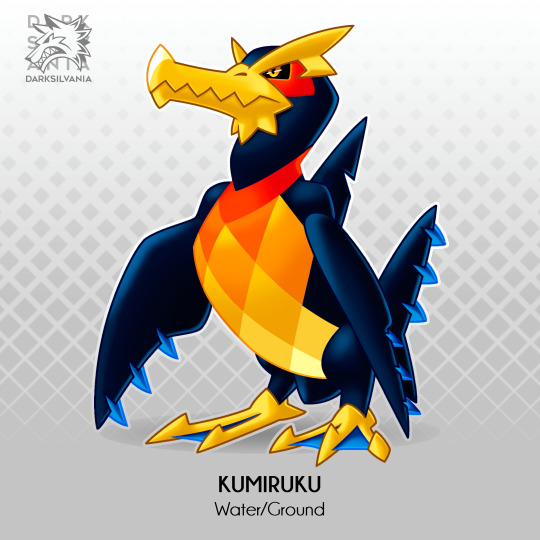
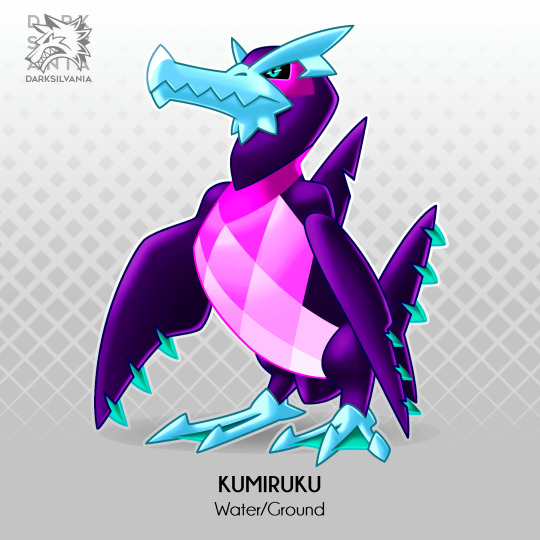
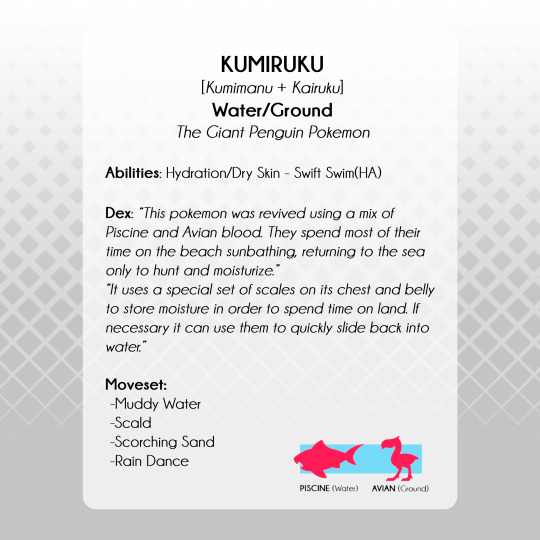
KUMIRUKU (Water/Ground)
The fourth of the six fossil hybrids, obtained from mixing the Piscen and Avian samples you get from PALEOLITO
It is based in prehistoric giant penguins, its name is a combination of Kumimanu and Kairuku, two genus containing some of the largest penguins to ever live
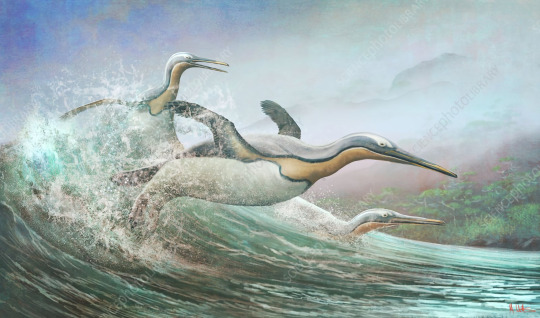
#pokemon#fakemon#fakepokemon#penguin#prehistoricpenguin#fossil#fossilpokemon#fossilfakemon#waterpokemon#waterfakemon#watertype#grounpokemon#groundfakemon#groundtype#kumimanu#kairuku#kumimanubiceae#kairukuwaewaeroa#fakemonart#fakemonartist
287 notes
·
View notes
Text
Fossil Novembirb: Day 3 - Race to the Sea

During the start of the Cenozoic, the oceans were relatively empty. Gone were the great marine reptiles like mosasaurs and plesiosaurs, as were ammonites and many large predatory fish. As soon as birds could, they entered the ocean to reap its bounties, whether by flying over the surface or diving to the depths. This is especially evident in Aotearoa (New Zealand), where lots of early seabirds, including the first penguins, were found in Paleocene sediments dating about 62 million years ago.
Kumimanu: One of the largest known penguins, and one of the earliest, standing over 1,5 metres tall and weighing 90-150 kilograms.
Sequiwaimanu: Another early penguin, known from a skull that preserves a long, spear-like beak.
Muriwaimanu: A relatively small early penguin. Like other early penguins, it had relatively long legs and somewhat flexible wings.
Kupoupou: A small early penguin with derived traits, like a flipper-like wing and short legs.
Waimanu: The earliest known penguin, and also relatively large at the size of the modern king penguin (Aptenodytes patagonicus)
Protodontopteryx: The earliest known pelagornithid, large soaring marine birds. This earliest member of the family sports a "modest" 2-metre wingspan.
Clymenoptilon: An early representative of tropicbirds that may have lived somewhat like a tern.
#Fossil Novembirb#Novembirb#Dinovember#birblr#palaeoblr#Birds#Dinosaurs#Cenozoic Birds#Kumimanu#Sequiwaimanu#Kumiwaimanu#Kupoupou#Waimanu#Protodontopteryx#Clymenoptilon
45 notes
·
View notes
Text
Kumimanu fordycei Ksepka et al., 2023 (new species)

(Type specimen of Kumimanu fordycei [scale bars = 10 mm; with bones of an emperor penguin, Aptenodytes forsteri, the largest extant penguin, for scale in 1 and 3], from Ksepka et al., 2023)
Meaning of name: fordycei = for R. Ewan Fordyce [New Zealand paleontologist]
Age: Paleocene (Thanetian)
Where found: Moeraki Formation, Otago, New Zealand
How much is known: Partial skeleton of one individual, including parts of the right wing.
Notes: K. fordycei was a close relative of modern penguins. Many Paleogene members of the penguin lineage grew much larger than the biggest living penguins, and K. fordycei may be the largest discovered so far. Estimates of its body mass suggest it might have weighed around 150 kg, comparable in size to a large ostrich.
The only other species of Kumimanu that had previously been named was K. biceae, which is also known from the Moeraki Formation, but was a bit smaller than K. fordycei (though still huge) and had a slightly differently shaped humerus (upper arm bone). Like modern penguins, members of the genus Kumimanu were flightless wing-propelled diving birds; however, they still retained some similarities to flying birds in their wing skeleton, which may suggest that they were less specialized for diving than penguins are today.
Reference: Ksepka, D.T., D.J. Field, T.A. Heath, W. Pett, D.B. Thomas, S. Giovanardi, and A.J.D. Tennyson. 2023. Largest-known fossil penguin provides insight into the early evolution of sphenisciform body size and flipper anatomy. Journal of Paleontology advance online publication. doi: 10.1017/jpa.2022.88
#Palaeoblr#Birblr#Dinosaurs#Birds#Kumimanu fordycei#Paleocene#Oceania#Phaethoquornithes#2023#Extinct
20 notes
·
View notes
Text
Fossilized Remains of 340-Pound Giant Penguin Found in New Zealand
— Sputnik | Wednesday February 08, 2023
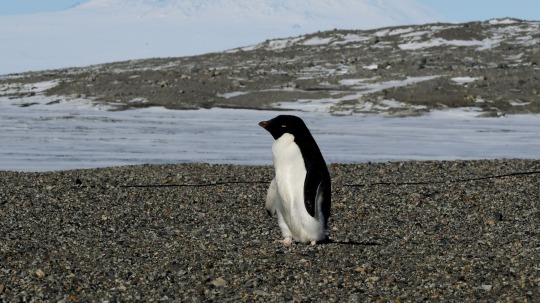
There are 17 to 19 species of penguins living today, most in the Southern Hemisphere. Also found in New Zealand and parts of Zealandia, are other flightless birds - like an ancestor to New Zealand’s beloved Kiwi and a giant “elephant bird” that also lived in Madagascar as recently as 800 years ago.
Fossilized remains of the largest penguin known to science were recently discovered in New Zealand, shocking researchers who determined the massive bird weighed hundreds of pounds.
Named Kumimanu Fordycei, Paleontologists believe the species could have weighed up to 340 pounds. By comparison, the average adult Male Western Lowland Gorilla Weighs about 300 pounds.
The fossil was discovered in a 57-million-year-old boulder that had been cracked open with the tides. Along with it they also found the remains of several individual specimens of another large but not quite as big previously undiscovered ancient penguin named Petradyptes stonehousei and fragments of two smaller yet-unnamed species of ancient penguins.
Scientists estimate the newly-discovered penguins lived around 60 million years ago. Petradyptes, they estimate, weighed around 110 pounds, far smaller than the Kumimanu, but still large for a penguin. The emperor penguin, the largest penguin on Earth today, can weigh up to just 88 pounds.
The fossils were discovered by Alan Tennyson, a paleontologist at the Museum of New Zealand Te Papa Tongarewa in 2017, but were described and named on Wednesday in the Journal of Paleontology.
Most of what scientists know about the Kumimanu fordycei came from a humerus bone, which was nine and a half inches long - about twice the length of those in the emperor penguin.
Paleontologists have been unable to determine the height of the ancient giant penguin but one estimated that it probably stood about 5 feet 2 inches. That gives the giant penguin a stocky build - the average aforementioned Western Lowland Gorilla 🦍 stands at about 6 feet while being roughly 40 pounds lighter.
Coming from an older branch of the tree of the penguin evolutionary tree, both the Kumimanu and Petradyptes differed in appearance from modern day penguins in more ways than just their size. Paleontologists say they had primitive flippers that resembled flying and diving birds like puffins. Their leg structure was also angled forward, unlike modern penguins whose legs are shaped like an upside down “L” coming out of their spine.

Scientists Discover New Penguin Colony in Antarctica Using Satellite Imagery (January 20, 2023)! “This is an exciting discovery. The new satellite images of Antarctica's coastline have enabled us to find many new colonies. And whilst this is good news, like many of the recently discovered sites, this colony is small and in a region badly affected by recent sea ice loss,” the British Antarctic Survey's Dr Peter Fretwell said.
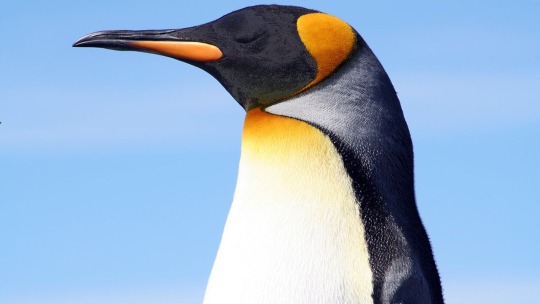
'Human-Sized Penguin' Uncovered by New Zealand Schoolchildren Reveals Ancient Species (09/17/202)!
Mike Safely, president of the Hamilton Junior Naturalist Club, says this is an experience that the children involved will remember for the rest of their lives. “It was a rare privilege for the kids in our club to have the opportunity to discover and rescue this enormous fossil penguin.”
Dr. Daniel Thomas, a senior lecturer in zoology from Massey’s School of Natural and Computational Sciences, determined that the fossil was between 27.3 million and 34.6 million years old. Thomas compared the identified species to the Kairaku penguins that were first described from Otago, but with much longer legs.
"Longer legs would have made the penguin much taller than other Kairuku species while it was walking on land; perhaps around 1.4m tall, and may have influenced how fast it could swim or how deep it could dive."
New Zealand has been a hot spot for finding ancient penguin fossils. In 2017, a closely related Kumimanu biceae was described as living just a few million years after the fordycei and weighed 220 pounds. The slightly slimmer giant penguin had a sharp “stork-like” beak that researchers think may have been used to stab prey. The beak of the Kuminmanu fordycei has not yet been discovered.
In 2021, a 4.5-feet tall penguin with unusually long legs was described after a group of students in a fossil hunting club found fossilized remains on a small peninsula in the Kawhia Harbor during a field trip.
One explanation for why giant penguins thrived at the time is because they evolved shortly after the meteor that killed off the dinosaurs hit Earth. That impact also killed most of the sea-faring reptiles, leaving a niche open for a large amphibious predator to fill their space. Sea-faring mammals, like seals and whales, had not yet evolved. Paleontologists hypothesize that once mammals reentered the sea, the giant penguins were out-competed and only the smaller penguins survived.
It is also worth noting that scientists now believe New Zealand and the Island of New Caledonia are a part of the Earth’s eighth continent, with most of the landmass sitting below the sea. This continent is known as Zealandia, which they believe broke off from the Southern Hemisphere supercontinent of Gondwana about 105 million years ago.
What would become Zealandia then stretched out in a process scientists don’t yet understand. Scientists are still debating if most Zealandia was always submerged, with just small islands poking out, or if it sank at one point. In either case, a sinking continent or a collection of islands make for a natural habitat for penguins. If it did sink, scientists estimate that it would have taken over a hundred million years, meaning the giant penguins could have lived while much of Zealandia was still above sea level.
#New Zealand 🇳🇿#Penguin 🐧#Giant Fossilized Remains of Penguins 🐧 🐧 🐧#Sputnik International#Kumimanu Fordycei#Western Lowland Gorilla 🦍#Paleontologists#Petradyptes#Peninsula | Kawhia Harbor#Island of New Caledonia 🇳🇨 | New Zealand 🇳🇿#Southern Hemisphere | Supercontinent of Gondwana
2 notes
·
View notes
Text

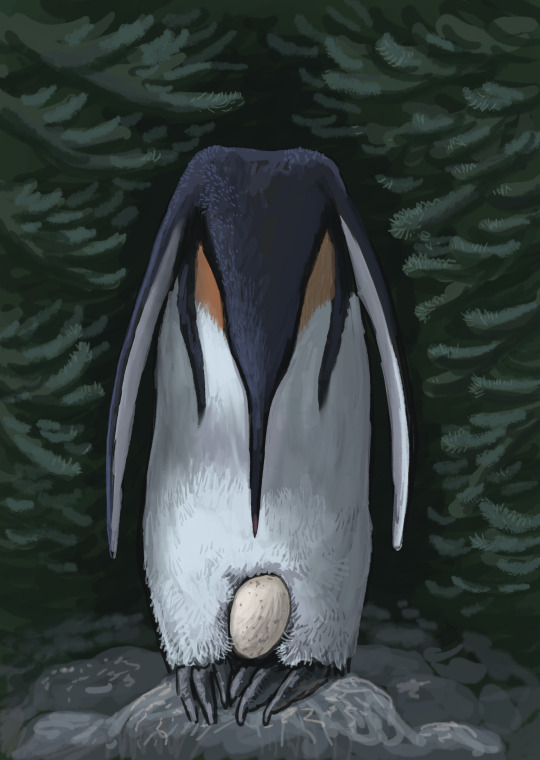
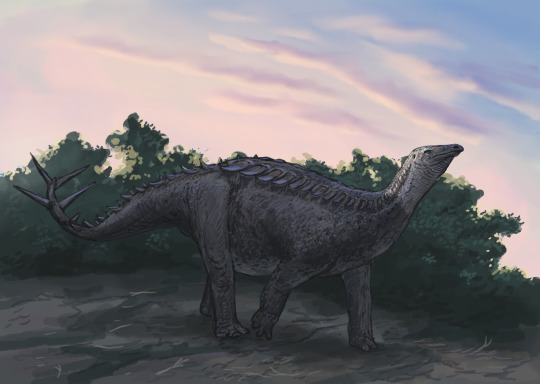

Results from the #paleostream
Carcinosoma, Kumimanu, Thyreosaurus and Transpithecus
298 notes
·
View notes
Text
ITS ALMOST FOSSIL NOVEMBIRB!!!!!
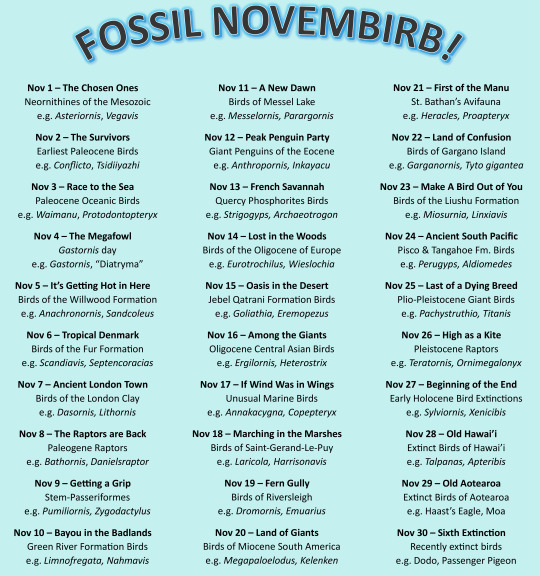
We're going to have a CELEBRATION of FOSSIL NEORNITHINES for this November!!! The extinct members of the only group of dinosaurs we have today!
Each day will have a prompt inspired by the evolution of crown-birds and the amazing forms they have taken over the past 68 million years!
You can respond to each day's prompt however you wish - with drawing and painting, writing, sculpting, music, videos, whatever! Just tag it "#Fossil Novembirb" for me to find it, and it'll get reblogged!
I'm so excited to see the art you guys create!
NOVEMBER 1 - THE CHOSEN ONES
Crown-Birds (Neornithes) known from the Mesozoic Era!
Options include Asteriornis, Teviornis, Vegavis, and "Styginetta"!
These are the only dinosaurs that survived the asteroid!
Theoretically there were also early Palaeognaths and Neoavians - if you want to do some spec evo and hypothesize what you think they might have looked like, go ahead! Follow your dreams!
NOVEMBER 2 - THE SURVIVORS
The earliest birds known after the K-Pg boundary!
Options include Conflicto, Tsidiiyazhi, Australornis, Qinornis, and Qianshanornis!
Birds diverged rapidly after the extinction, so also feel free to dive into spec evo into some of the forms we don't have fossils of!
NOVEMBER 3 - RACE TO THE SEA
The first Marine Neornithines and how they evolved in the early Paleocene!
Includes tons of early penguins like Waimanu, Kumimanu, Sequiwaimanu, Muriwaimanu, and Kupoupou
Also includes the first Pseudo-toothed bird, Protodontopteryx, and the earliest known Tropicbird, Clymenoptilon!
RISE OF THE PENGUINS!
NOVEMBER 4 - THE MEGAFOWL
Gastornis (aka "Diatryma", aka "Zhongyuanus") appeared in the mid-Paleocene and was a feature of the Cenozoic landscape until the end of the Eocene - so we have a whole day JUST FOR IT
Show your love for the Megafowl Gastornis! This giant herbivorous bird was fascinating, and has captured imaginations for decades because of it!
Gastornis is also present in many of the ecosystems described below, such as Willwood, Green River, and Messel, so we also just wanted to make sure people didn't keep picking Gastornis over and over again xD
NOVEMBER 5 - IT'S GETTING HOT IN HERE
The Paleocene-Eocene Thermal Maximum was the most dramatic incident of rapid global warming in the world since the Permian... until today!
It majorly affected the evolution of many things, possibly including birds!
The Willwood Formation straddles the time period of the warming, and has tons of birds that were evolving during that time period! So, for this day, create things involving birds of the Willwood Formation!
Options include the flighted Palaeognaths Lithornis promiscuus and Lithornis plebius; the possible stem-Ostrich Paragrus, the early half-screamer-half-duck Anachronornis, the early owl Primoptynx, and the fascinating stem-mousebird Sandcoleus! And many more!
NOVEMBER 6 - TROPICAL DENMARK
Birds of the Fur Formation, one of the best collections of bird fossils from the early Eocene!
Includes such friends as Scandiavis (an early shorebird), Septencoracias (an early roller), Pellornis (an early rail-esque thing), the utterly mysterious Morsoravis, and the early swift-hummingbird Eocypselus!
This was a tropical shoreline environment with many of the first members of major bird groups we see today!
NOVEMBER 7 - ANCIENT LONDON TOWN
Across the shore from Fur was the London Clay Formation, a lush tropical forest near the warm shallow ocean
In addition to a truly alarming quantity of plant fossils, this is a notable locality for early birds, featuring many early members of major groups much like the Fur Formation
Options include Dasornis (a pseudotoothed bird), Pulchrapollia (one of the Parrot-Passerines of Prey), Nettapterornis (another stem-duck), Nasidytes (an early loon), Charadriisimilis (an early shorebird), Archaeodromus (a trogon-like member of Strisores), Eotrogon (an actual early Trogon), Lithornis vulturinus (another flighted Palaeognath), Prophaethon (another early Tropicbird), and Ypresiglaux (an early owl) - and so many more!
NOVEMBER 8 - THE RAPTORS ARE BACK
Turns out "Predatory Feathered Thing with Really Sharp Foot Claws" is a very successful niche - not only was there potentially one right after the end of the Cretaceous (Qianshanornis), but other raptors were some of the first birds to succeed around the world in the Eocene
So this day is dedicated to the early raptors of the Cenozoic!
Any "raptor" from the Paleogene is valid - so here are some suggestions: Early Cariamiformes (Seriemas and Kin) like Bathornis, Dynamopterus, Strigogyps, and the first potential Terror Birds like Paleopsilopterus Early Owls like Ypresiglaux and Palaeoglaux Early Accipitriformes like Horusornis Early Falcons like Antarctoboenus, Masillaraptor, and Danielsraptor And of course the ever popular "Parrot-Passerines of Prey" like Tynskya and Messelastur
NOVEMBER 9 - GETTING A GRIP
Half of all living birds are Passeriformes - aka "Perching Birds" - but this wasn't always the case! For most of Earth's history, many other kinds of tree birds were extremely common
Where did this behemoth group of tiny dinosaurs come from? That's the subject of this day's prompt!
In the Eocene, the first birds closer to Passeriformes than to Parrots evolved, and they came in a huge variety of forms! So on Nov 9th, we're going to celebrate this group's interesting beginnings!
Options for this include Parapsittacopes, Eofringillirostrum, Pumiliornis, Psittacopes, Zygodactylus, Primozygodactylus, Psittacomimus, Sororavis, Morsoravis, and Eozygodactylus! Go wild!
NOVEMBER 10 - BAYOU IN THE BADLANDS
Back to specific ecosystems! We're visiting the world-famous Fossil Lake of the Green River Formation!
This environment, during the Early Eocene, was a thriving tropical lake and forest ecosystem filled with tons of early Neornithines as well as mammals and other animals
Gorgeous fossils have come out of this lake, showing truly amazing detail of feathers and other features for these birds!
So here you can feature Prefica (a potential early Oilbird), the flighted Palaeognath Calciavis, the stem-turaco Foro, the early mousebird Celericolius, the possible shore-bird Nahmavis, a potential cuckoo roller Plesiocathartes, the Flamingo-Duck Presbyornis, the early landfowl Gallinuloides, the swift-hummingbird Eocypselus, and the Frigate Bird Trying at being a Gull Limnofregata - and so many more!
NOVEMBER 11 - A NEW DAWN
We're finally moving on to the middle Eocene - and the Messel Lake ecosystem, famous from the first episode of Walking with Beasts (hence the name of the day)!
(If you're going "wait, that episode acts like nothing happened between the K-Pg and Messel, but here you have 10 days worth of stuff" .... yeah. Walking With Beasts skipped the Paleocene and early Eocene and I am... very pissed. Still.)
You know about the tons of early mammals from this tropical lake ecosystem, but it was filled with tons of early birds as well!
There's the early ostrich Palaeotis, the crane-rail Messelornis, the almost-flamingo Juncitarsus, the freshwater Booby Masillastega, the early hoopoe Messelirrisor, Selmes (a mouse bird with stubby toes), the early ibis Rhynchaeites, the early nightbird Hassiavis, the early swift Scaniacypselus, an early roller with known colors Eocoracias, and the early potoo Paraprefica - and many others!
NOVEMBER 12 - PEAK PENGUIN PARTY
As the Eocene continued, penguins achieved true megafaunal status - there were tons of them, they were huge, and they were all over the oceans of the Southern Hemisphere
While penguin diversity never did recover after the Eocene-Oligocene extinction event, this golden age deserves celebration!
Some of these fascinating peak penguins include Palaeeudyptes, Anthropornis, Icadyptes, Inkayacu, Perudyptes, and Kairuku!
NOVEMBER 13 - FRENCH SAVANNAH
As the Eocene began to dry up and cool down, plains grew across the world where the tropical forests once had been
One of the most famous later-Eocene fossil sites for birds is the Quercy Phosphorites location, a French formation with tons of interesting fossil birds!
Here we start to see the early forms of Neornithine Dinosaurs we saw in the Paleocene-Early Eocene diverge and specialize further - often in particularly weird or interesting ways!
So here we have the duck-ish chicken Paraortyx, the secretarybird Pelargopappus, you can also bring back Dynamopterus from earlier, there is the stem-chicken Quercymegapodius as well as stem-parrots like Quercypsitta, the seriema-like Strigogyps, the sandgrouse relative Archaeoganga, Archaeotrogon shows up again, the swift relative Aegialornis, a potential woodpecker relative Sylphornis, and more owls like Palaeoglaux! Lots of cursorial predators in this ecosystem!
NOVEMBER 14 - LOST IN THE WOODS
As the Oligocene dawned, forests did grow back in Europe, though they were now temperate and dry as opposed to the paratropical rainforests of before
This lead to wide diversification of tree-dwelling birds, and so here we will celebrate the birds of the Oligocene of Europe!
We start to really see modern-esque birds at this point, though of course we still have 30 million years of evolution to go!
Here you can feature the early eagle/hawk Aviraptor, the European Hummingbird Eurotrochilus, the seabird relative Rupelornis, the early woodpecker-toucan Rupelramphastoides, the tody Palaeotodus, the proper Passerine Wieslochia, the possible shorebird Turnipax, the mousebird Oligocolius, the hoopoe Laurillardia, and the trogon Primotrogon which we know the colors of!
NOVEMBER 15 - OASIS IN THE DESERT
The Jebel Qatrani Formation of Egypt shows the beginnings of the famous African Grassland animals, as well as many early members of iconic African animal groups such as primates - and, of course, birds!
Taking place in the early Oligocene, this formation was a tropical/subtropical lowland plain filled with ponds and streams and other waterways - aka, tons of swamps surrounded by plains
As such, this place is infested with waterbirds!
Here we have a fossil relative of the Shoebill Goliathia, as well as the jacanas Janipes and Nupharanassa, the giant stork Palaeoephippiorhynchus, the herons Nycticorax and Xenerodiops, and the mystery Palaeognath Eremopezus!
NOVEMBER 16 - AMONG THE GIANTS
Once again we're just fully committing to the Walking With Beasts nostalgia bc these are the birds we wish were in it more okay we said it
Anyways there were some interesting large birds in the plains of the "Land of Giants" episode so picture these guys alongside the Indricothere etc.
In general we're covering the latest Eocene through the Oligocene of Central Asia
Here we have the enigmatic ratites Ergilornis and Sonogrus, the pseudo-toothed bird Caspiodontornis, the owl Heterostrix, and the stem-flamingo Agnopterus
NOVEMBER 17 - IF THE WIND WAS IN OUR WINGS
We all focus on penguins, but over the Cenozoic, plenty of weird birds have evolved for marine life, and boy are they bizarre!
So for Nov 17, we're focusing on the unusual marine birds of the Cenozoic!
This includes any members of the Pelagornithids - aka the Pseudo-toothed birds - as well as the Plotopterids - the Boobies that became Penguins! Pelagornis and Copepteryx are the best known taxa from each, respectively, but there are plenty more!
But that's not all! We have the flightless auks Miomancalla and Mancalla, the large flightless marine duck Chendytes, and who can forget the weird flightless marine swan Annakacygna! Tons of options to choose from!
NOVEMBER 18 - MARCHING IN THE MARSHES
We're now starting our transition from the Paleogene into the Neogene, beginning with the brackish marsh ecosystem preserved at Saint-Gerand-Le-Puy in France!
This Miocene locality preserves a wide variety of birds that are near modern, but not quite - a sort of "uncanny valley" of bird evolution, all set in a somewhat-salty somewhat-not wetland ecosystem
Options for dinosaurs here include Harrisonavis, a transitional flamingo; the early gull/tern Laricola, the enigmatic duck Mionetta, the stork Grallavis, the pratincole Becassius, the swimming-flamingo Palaelodus, the early cormorant Nectornis, the seed-eating pheasant Palaeortyx, the early loon Colymboides, and the mysterious shorebird Elorius!
NOVEMBER 19 - FERN GULLY
Riversleigh is one of the most famous fossil sites in the world, preserving the evolution of the strange and unique animals known today in Australia, during the Oligocene to Miocene transition
Most often, we focus on the bizarre mammals found at Riversleigh, and for good reason - it's a Marsupial Party! - but the birds here are fantastic as well
This ecosystem was a rich rainforest that transitioned over the period of deposition into a semiarid grassland, and covers 20 million years of animal evolution during that transition
Options for birds here include the butcherbird Kurrartapu, the fossil Sittella Daphoenositta trevorworthyi, the Mihirungs ("Demon Ducks") Dromornis and Barawertornis, the Emuwary Emuarius, the early magpie-goose Eoanseranas, the raptor Pengana with flexible ankles, the earliest known species of lyrebird (Menura tyawanoides), the corvid-like Corvitalusoides, the first known cockatoos, the flightless rail-like bird Australlus, the stiff-tailed duck Pinpanetta, the early logrunner Orthonyx kaldowinyeri, and so many more!
NOVEMBER 20 - LAND OF GIANTS
Y'all were probably wondering when we'd get to the Terror Birds and other interesting dinosaurs of South America, so - here we are!
South America, isolated from the rest of the world until the Great American Interchange, featured a wide variety of bizarre and unique animals - not just mammals, but birds and other reptiles as well!
So for Nov 20th, we're looking at the interesting dinosaurs of the "lost continent" during the Miocene epoch, prior to the invasion of North American taxa!
Any Miocene South American Terror Bird (Phorusrachid) is fair game here, so that includes Brontornis, Patagorhacos, Paraphysornis, Devincenzia, Kelenken, Phorusrhacos, Patagornis, Andalgalornis, Psilopterus, Mesembriornis, and Procariama! Note that they did not all live at the same time or even close to each other in location, so do your research on the taxa you pick!
But Terror Birds weren't the only strange dinosaurs in South America at the time! We have the large Teratorn (vulture-like-thing) Argentavis, the *giant* swimming-flamingo Megapaloelodus, the giant Anhinga Macranhinga, the rhea Opisthodactylus, the penguins Palaeospheniscus, Arthrodytes, and Paraptenodytes, the Cathartid Dryornis, the Jacamar Galbula hylochoreutes, fossil Hoatzins like Hoazinavis and Hoazinoides, the giant stork Leptoptilos patagonicus, and the owl Yarquen!
NOVEMBER 21 - FIRST OF THE MANU
Aotearoa has one of the most unique avifaunas in the world today, and I often call it "Mesozoic 2" because of its almost entirely dinosaur-dominated fauna, especially in the past
All great things have to start somewhere or when, and for Aotearoa, that somewhen was after the landmass resurfaced from the ocean for the first time in millions of years - and was quickly inhabited by all kinds of birds and other reptiles (including tuatara) in the Miocene
This ecosystem was a lake bordered by grassy wetland floodplains and subtropical forests, a bit warmer than Aotearoa today
Dinosaurs here include the early Kiwi Proapteryx, an unnamed early Moa, a truly alarming number of waterfowl including shelducks like Miotadorna, stiff-tailed ducks like Manuherikia, and the possible swan Notochen, the small swimming-flamingo Palaelodus aotearoa, pigeons like Rupephaps and Deliaphaps, an early adzebill Aptornis proasciarostratus, flightless rails like Priscaweka, the lake-wanderer Hakawai melvillei, the herons Pikaihao and Matuku, the giant parrot Heracles, proto-keas Nelepsittacus, and the New Zealand Wren Kuiornis. Tons of fun species to choose from!
NOVEMBER 22 - LAND OF CONFUSION
In the Late Miocene to Early Pliocene, the Italian province of Gargano was cut off from the mainland due to rising sea levels, turning it into an island - an island with lots of really strange birds!
This island was cut off from everything else and completely lacked large predators, allowing for a weird variety of animals to evolve and thrive prior to the island rejoining the mainland during the Ice Age
Strange birds of this ecosystem include the extremely old pigeon Columba omnisanctorum, the giant hawk Garganoaetus, the giant flightless goose Garganornis, the giant barn owl Tyto gigantea, the pheasant Palaeortyx volans, and the swift Apus wetmorei!
NOVEMBER 23 - MAKE A BIRD OUT OF YOU
The iconic animals of the Ice Age and recent prehistory had to come from somewhere, and much of this transition is recorded in the Chinese Ecosystem of the Liushu Formation, deposited between 11 and 6.4 million years ago
As grasslands expanded, this ecosystem transitioned from a forest to a wide plains, and many animals adapted for the grasslands accordingly, leading to the appearance of such mammals as Elasmotheriines, Sabercats, Hyenas, Ambelodonts, and a truly alarming quantity of hoofed mammals
Dinosaurs (Birds) adapted to this ecosystem change as well, of course! While most focus on the mammals of Liushu, we're here to showcase the interesting birds that appeared here as well!
Options here include the the very well preserved Falcon Falco hezhengensis, the vultures Mioneophron and Gansugyps, the diurnal owl Miosurnia, the vocally fancy pheasant Panraogallus, the sandgrouse Linxiavis, the Ostrich Struthio (or Orientornis) linxiaensis, and the probable-Ostrich Sinoergilornis
NOVEMBER 24 - ANCIENT SOUTH PACIFIC
Penguins are Bouncing Back! As the Miocene continued and the Pliocene began, many new types of marine birds showed up and were fossilized in locations in Chile (Pisco) and Aotearoa (Tangahoe)
Tons of interesting birds were preserved in this sort of transitional ecosystem, showcasing how birds adapted to changing conditions as the Miocene-Pliocene climatic turmoil continued
These near shore environments are probably more famous for their other animals - things like the giant shark "megalodon", as well as weird whales like Livyatan and Odobenocetops and aquatic giant sloths (like Thalassocnus) and marine crocodilians - but we're here for those dinosaurs!
Options here from the Pisco Formation include the "Toucan-Booby" Ramphastosula, the Cathartid Perugyps, the Booby Sula figueroae, Pelagornithids, Pelicans, and the penguins Spheniscus urbinai and Spheniscus megaramphus, whereas birds from the Tangahoe Formation include the narrow-beaked albatross Aldiomedes, the giant petrel Macronectes, the more regular-sized petrel Procellaria altirostris, the little penguin Eudyptula wilsonae, and the crested penguin Eudyptes atatu!
NOVEMBER 25 - LAST OF A DYING BREED
We all love Megafuana, even though they are usually the "Live Fast Die Young" kind of species - gobbling up resources and growing too big will do that to you
Usually when we hear the term "Megafauna" we think of Mammals and Non-Avian Dinosaurs, but birds have had their share too - and have lost their share as well
So, mainly to cater to the Megafauna Fanbase, here we dedicate a whole day to the giant birds of recent times - Pliocene through Pleistocene - that we have lost to the dramatic climate change of the Ice Age Era. (Those lost in the Holocene will get their own days, see below)
Options for this day include the giant ostrich Pachystruthio, the Mihirung Genyornis, the Terror Bird Titanis, the giant stork Leptoptilos robustus, the giant swan Cygnus falconeri, the giant Anhinga Giganhinga, and of course - we can't forget our friend - the last of the Pseudotoothed Birds, Pelagornis
NOVEMBER 26 - HIGH AS A KITE
In many ways, the real dinosaur winners of the Ice Age were the flying Birds of Prey, as there were many kinds of raptors during the Ice Age and they exploited the new environment expertly
Nothing like being able to traverse huge distances to find places where there are food, amiright?
So this day is dedicated to the fantastic Raptors of the Ice Age, both volant and not!
Here we have some of the last of the Teratorns like Teratornis itself, the Giant Australian Raptor Dynatoaetus, the Australian Vulture Cryptogyps, Woodward's Eagle Buteogallus woodwardi, the tiny Condor Wingegyps, the large Cuban Eagle Gigantohierax, the wandering vulture Neogyps, the Walking Eagle Buteogallus daggetti, the Giant Cuban Stilt-Owl Ornimegalonyx, and one of the last Terror Birds, Psilopterus
NOVEMBER 27 - BEGINNING OF THE END
Oh Holocene Extinctions. As upsetting as they are, they include some of the best known fossil/subfossil birds, so we decided to spend a little extra time on them than they should have based solely on the time length
Here, we highlight the early losses of the Holocene - those dinosaurs that went extinct at the start, largely due to direct human activity such as hunting in addition to the warming caused by the end of the last Ice Age/Glacial Maximum
Days will be dedicated to both Hawai'i (see below) and Aotearoa (again, below), so this is for everyone else!
So options here include the previously mentioned marine duck Chendytes, the giant flightless landfowl Sylviornis from New Caledonia, the famous Elephant Birds of Madagascar, the flightless clubbing-ibis Xenicibis, the weird puffin Fratercula dowi, the giant Bahama Eagle Titanohierax, the Californian Turkey Meleagris californica, and the flightless "Cave Rail" Nesotrochis of the Greater Antilles
NOVEMBER 28 - OLD HAWAI'I
Many, many, MANY unique dinosaurs live on islands. The islands of Hawai'i are no exception, and these islands have lost many unique and fascinating birds over the years - thanks to human activity, invasive cats, colonialism, and climate change
We couldn't possibly ignore them, so for this day, we are hilghlighting these amazing animals found across the archipelago
There are tons of options, but some of our recommendations include the reverse-platypus/Mole Duck Talpanas, the Stilt-Owl Grallistrix, the flightless ibis Apteribis, the Moa-Nalo like Chelychelynechen, Ptaiochen, and Thambetochen, the Wood Harrier Circus dossenus, Hawai'ian Honeycreepers like Drepanis, Aidemedia, Hemignathus, Chloridops, Akialoa, Rhodacanthis, Dysmorodrepanis, Telespiza, and Vangulifer, the Oloma'o and ʻĀmaui thrushes, ʻōʻō's/Hawai'ian Honeyeaters like the Kioea, Kauaʻi ʻōʻō, and Oʻahu ʻōʻō, the giant Hawai'i Goose, the nēnē-nui/wood-walking goose, the Robust Crow, the flightless Laysan Rail, and the O'ahu Petrel
NOVEMBER 29 - OLD AOTEAROA
We're finally here: Pre-Human Holocene Aotearoa, aka Mesozoic 2, aka The Land Where Mammals Ain't Shit
I love Aotearoa so much. Why wasn't I born there. The universe isn't fair.
The ecosystems were very similar to today - podocarp forests and southern beech forests, grass and tussock plains and shrublands, and plenty of coastal habitats, all usually temperate in terms of climate
All named Moa are fair game. All of them, all named members of Dinornithiformes. So the North Island Giant Moa, the South Island Giant Moa, the Bush Moa, the Eastern Moa, the Broad-Billed Moa, the Heavy-Footed Moa, Mantell's Moa, the Crested Moa, and the Upload Moa. Follow your Moa-Filled Dreams!
Obviously there were more than Moa - not just the living species of Aotearoa still with us, but tons of other extinct forms for Fossil Novembirb. This includes the Adzebills, Haast's Eagle (of course), the whēkau/Laughing Owl Ninox albifacies, the New Zealand Goose Cnemiornis, the New Zealand Owlet-Nightjar, the mehonui Diaphorapteryx, the Long-Billed Wren Dendroscansor, the piopio Turnagra, and the Huia
NOVEMBER 30 - SIXTH EXTINCTION
And, for our last day, we cover recent Holocene extinctions (not on Hawai'i or Aotearoa) - the birds/dinosaurs we have lost in the living past, due largely to colonialism, capitalism, globalism, and climate change
Any bird extinct since 1492 not previously covered is fair game, and there are a lot of them. Today, we honor them, however we can.
Some suggestions include the Dodo (of course), the Cuban Macaw, the Pink-Headed Duck, the Northern Curlew, the Great Auk, the Passenger Pigeon, the Carolina Parakeet, the Ivory-Billed Woodpecker, the Labrador Duck, the Saint Helena Hoopoe, and the Spectacled Cormorant; though there are of course many otherse to choose from as well
Kind of a bummer note to end on, but here we are
Living Birds already get tons of time and attention, so we really don't want to include them here - we love them, but the fossils of the Neornithes world deserve love too! So we tried to cover all of the bases, as best as we could!
Remember, Wikipedia, the Paleobiology Database, The Works of Gerald Mayr, the third volume of "Earth Before Us", and the blogs of myself and @albertonykus and @otussketching are all fantastic resources to look for information about these wonderful animals! Also check out Through Time and Clades' "Dinosaurs: The Second Chapter" series and the Raptormaniacs blog from Albert as well!
HAVE FUN! CREATE WHAT YOU DREAM! AND LOVE CENOZOIC DINOSAURS!
HAPPY FOSSIL NOVEMBIRB!
#Fossil Novembirb#Novembirb#Dinovember#birblr#palaeoblr#Birds#Dinosaurs#Cenozoic Birds#Neornithines#Dinovembirb
612 notes
·
View notes
Text
New wasp species named after Doctor Who villain
‘Dalek’ wasps are among 815 new species described by Natural History Museum scientists in 2023
Nilima Marshall - 4 hours ago
Fourteen newly discovered species of wasps have been named after the villainous Daleks from Doctor Who to mark the 60th anniversary of the popular sci-fi series.
The insects, which bear the genus “Dalek”, are among the 619 new wasp species described this year by London’s Natural History Museum (NHM).
An alien warrior race of mutants, the Daleks are the formidable bad guys in BBC’s long-running TV show.
I thought it was a good name for a genus and a bit of fun having been a big fan of Doctor Who in my early years
Dr John Noyes, NHM
One particular species of wasp from Costa Rica called Dalek nationi also honours Terry Nation, the Welsh screenwriter and novelist who created the mutant race that terrified children for the past six decades.
Dr John Noyes, scientific associate at the NHM, said: “I thought it was a good name for a genus and a bit of fun having been a big fan of Doctor Who in my early years.”
A total of 815 new species were described by NHM scientists in 2023, including a 407-million-year-old parasitic fungus named after children’s author Beatrix Potter.
Potteromyces asteroxylicola was discovered infecting the roots of ancient plants and is thought to be the earliest disease-causing fungus ever discovered.
The researchers said they wanted to honour Potter’s reputation as a dedicated mycologist – someone who studies and works with fungi.
Dr Christine Strullu-Derrien, scientific associate at the NHM, who helped identify the new Potter fungus, said: “Naming this important species after Beatrix Potter seems a fitting tribute to her remarkable work and commitment to piecing together the secrets of fungi.”
Highlights also include fossil remains of a new dinosaur species found on the Isle of Wight, which was named Vectipelta barretti after NHM Professor Paul Barrett who worked there for two decades.
It is first the dinosaur discovered on the island for 142 years.
Other notable discoveries also include fossil remains of a giant penguin called Kumimanu fordycei – believed to be the largest penguin that ever lived – and nine new species of bristle worms including two bone-eating worms.
The researchers also report new species being discovered in “unremarkable” urban environments, including a stick insect called Micropodacanthus tweedae that was found on the side of a bin in Australia, and a moth that was located in Ealing, west London, called Tachystola mulliganae, which turned out be a new species native to Western Australia.
T. mulliganae is named after Barbara Mulligan, a lifelong moth enthusiast who discovered the species.
Mark Sterling, a scientific associate at NHM, described the finding as “real coup for citizen science”.
The new species descriptions contributed to the 722 new research papers released by the NHM over the past 12 months.
20 notes
·
View notes
Text
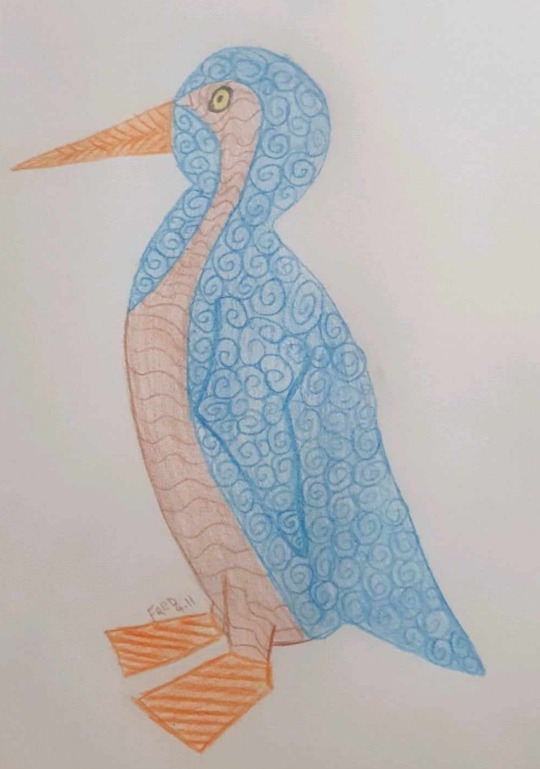
GIANT PENGUIN!!!!
A non-realistic attempt at Kumimanu for day three of Fossil Novembirb. I enjoy doing swirls
23 notes
·
View notes
Text
Fossil Novembirb, the first nine days
Hello World. I never thought I'd be on this site, but here I am. This blog was created for the purpose of participating in a-dinosaur-a-day's Fossil Novembirb. Fossil Novembirb is a yearly art event founded by Meig Dickson, a vertebrate palaeontologist who, as far as I can tell, studies dinosaurs, especially theropods. Don't fight me or em over birds being theropod dinosaurs. Neither ey nor I want to have this conversation, so enjoy the art!
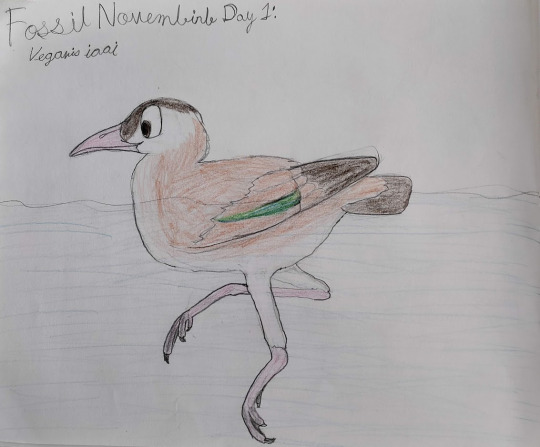
I started off my Fossil Novembirb with Vegavis iaai. What makes this fluffy anseriform special is that we found a fossilised syrinx (avian voice-maker) belonging to one of these, so we can reconstruct their sounds. This Vegavis was coloured based on a bunch of anseriforms that are alive today, like ruddy shelducks and cotton pygmy geese.

For Day 2, I did a bit of spec evo and pulled out a scientific name I told myself I'd assign to a newly-discovered fossil genus. This sketch has a Serina-like text description for Phantasmavis.
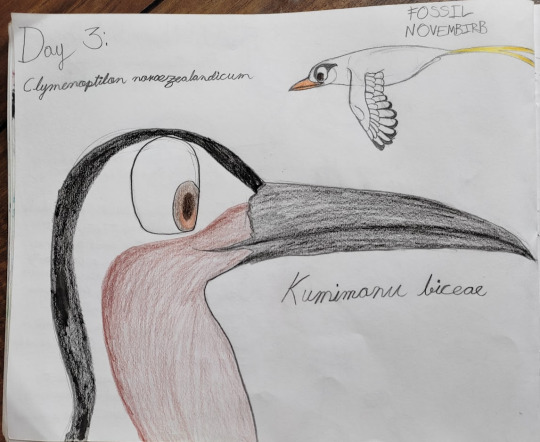
Tropicbirds! I chose to draw Clymenoptilon because I was hoping "tropicbird" meant "brightly coloured bird". Even though they aren't that brightly coloured, they're still cool. And Kumimanu (approximately to scale in this drawing) didn't really have the obligation to be black-and-white like most extant penguins (because Inkayacu), so I went... mild-wild with the colours.
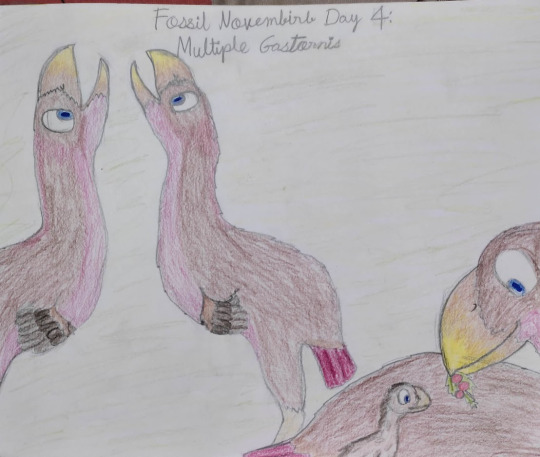
No... one's... tall like Gastornis, no one calls like Gastornis! In the bottom right, no one feeds small like Gastornis!
I've seen the "Andy's Prehistoric Adventures" episode featuring these megafowl, realised it was Walking With Dinosaurs with a human inserted, and drawn a mildly speculative colouration for these Gastornis. To the left, two adults have their necks out towards each other and are calling into the sky. Whether this is courtship or a challenge, nobody knows. But a calmer scene happens in the bottom right, where a mother shows her chick red berries on a branch to show them that it is food.
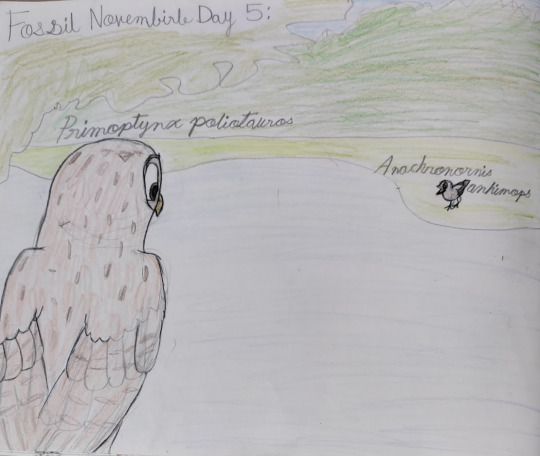
"Don't make me fly up there, you punk!" is one way to interpret the screamerduck Anachronornis' call in the direction of the Primoptynx owl. This scene unfolds in the Palaeocene-Eocene Thermal Maximum ecosystem of the Willwood Formation before it was rock.
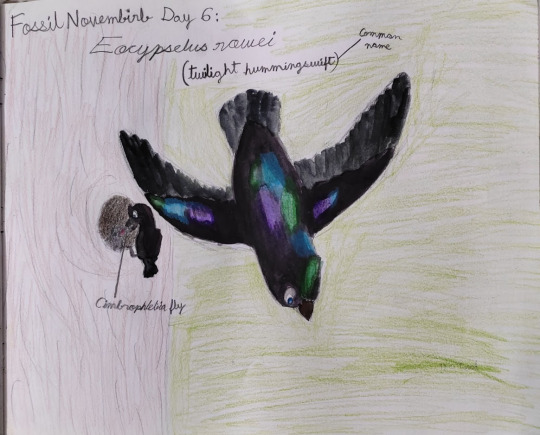
It's a twilight hummingswift! We know the colour of this iridescent little birb from the Danish Fur Formation. I watched a tutorial on painting iridescence, but I'm not really satisfied with the parent feeding their chick to the left of the flying Eocypselus rowei. It's hard to see, but there's a baby hummingswift being fed a Cimbrophlebia scorpionfly.
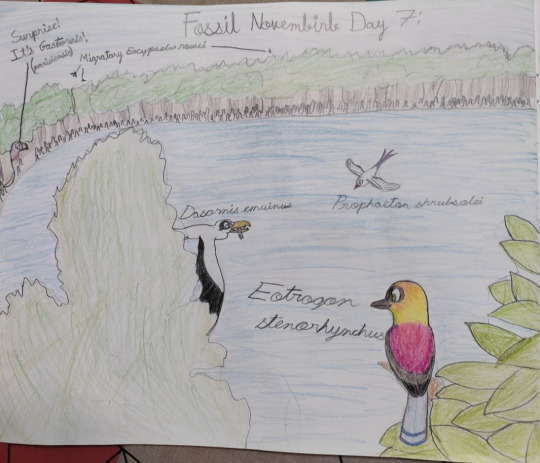
London Clay has a lot of plant fossils. Not all of them are listed on Wikipedia, but there's a photo of a pencil-root mangrove seed listed. Featuring a speculatively-coloured Eotrogon, a Dasornis carrying away a mackerel, and a Prophaeton just gliding, and repeat telecasts Gastornis parisiensis and Eocypelus rowei, Eocene London was a birder's dream (believe me, I'm a kinda-birder).
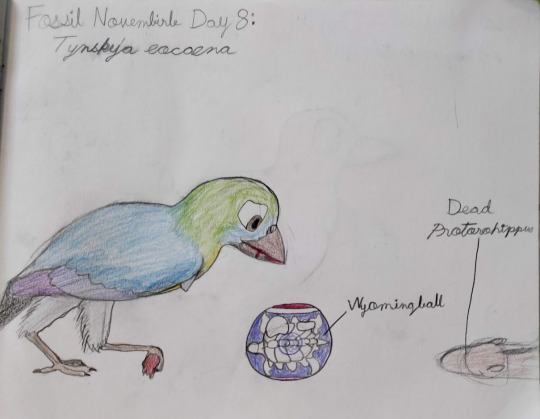
This Tynskya art was somewhat late, rather dissatisfactory, and mildly rushed. I had an exam the next day. Don't judge me.
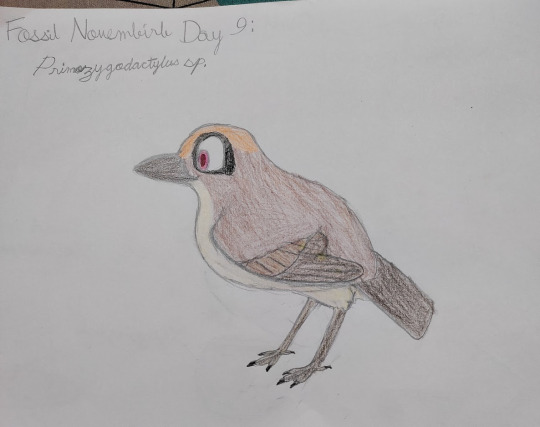
And here's a better Primozygodactylus! I couldn't tell the specific species because it wasn't listed for the Wikipedia image. But here we are: a bird that gives off ashy prinia/sparrow/orange-headed thrush vibes.
This concludes the first nine days! I don't know if I'll be doing the tenth because nobody's giving me straight answers about the palaeobotany of the Green River formation.
Enjoy!
#fossil novembirb#dinosaur#birds#paleoart#this site is as chaotic as it seemed when I first anonymously browsed eir blog#paleogene#palaeogene#eocene#cenozoic#maastrichtian
23 notes
·
View notes
Note
google kumimanu fordycei :) beeeeg new Zealand penguin :))
OH FUCK YEAHHHHHHHH AOTEAROA LAND OF THE BIG FAT BIRD
4 notes
·
View notes
Text
#1967 - Pygoscelis papua - Gentoo Penguin


Photo by @purrdence
The third largest living penguin species, after the Emperor and King, but see a wide range of other extinct species including the Monster Penguin Kumimanu biceae (1.6m, from New Zealand), the Kawhia giant penguin Kairuku waewaeroa (1.4m, from New Zealand), the Colossus Penguin Palaeeudyptes klekowskii (2m tall, from Antarctica), and of course the Blind Albino Penguin Aptenodytes albus (1.8m, from beneath the Mountains of Madness).
The names for this species are somewhat confusing - Gentoo is an Anglo-Indian term possibly derived from the Portuguese gentio ("pagan, gentile"), and may refer to a percieved resemblence between a turban and the white head mark. Another suggestion is that it’s derived from the Spanish for Johnny Penguin, that being the common English name in the Falklands.
The scientific name is much worse - the original description apparently thought the penguin lived in Papua New Guinea. The original Gentoo Penguin specimens came from the Falklands, and the nearest Gentoos to Papua live 6000km away. There’s also a "possibly fraudulent claim" in 1776 by French naturalist Pierre Sonnerat, who alleged a Papuan location for the King Penguin despite never having been to the island. Baffling all-round, honestly, especially since Johann Reinhold Forster, who wrote the description, was the naturalist on Captain Cook’s voyage of exploration that poked around the Antarctic in the first place.
The fastest-swimming penguin, feeding on krill, squat lobsters, shrimp, octopodes, and fish including cod icefish, unicorn icefish, and others.
There are at least four subspecies of Gentoo, all breeding on subantarctic islands, unlike their closest relatives the Adélies, who breed on the Antarctic mainland and Bouvet Island. Nests are built from jealously gaurded pebbles. Courtship involves involves careful inspection of the best pebbles, and males may attempt to seduce potential mates with choice rocks. This is a risky ploy - Gentoos are strongly monogamous, and infidelity is punished by exile from the colony.
As well as the usual risks posed by leopard seals, skuas and the like, Gentoo nests may be squashed by indifferent elephant seals, or accidentally crushed by livestock on the Falklands. Eggs are often laid in pairs, and both chicks raised to adulthood - a better deal than the Adélies get, where the spare chick is usually left to starve.
2 notes
·
View notes
Text
Haven't seen a lot of people talking about this, but new ancient penguin species just dropped recently, with an estimated live body mass range of 150-170 kg (330-375 lbs, or 23-27-ish stones)
Unfortunately there are no height estimates:
"We refrain from attempting comparisons of standing height or body length among these taxa, given that very different propor- tions of stem and crown penguins make such inferences difficult in the absence of nearly complete skeletons"
But we can use our imaginations: Emperor penguins are about 4 feet tall and weight about 50 pounds. The new Kumimanu fordycei weigh 7 times as much; if everything were proportional, weight would scale as the cube of height, so they'd be 7^(1/3) times as tall, which is pretty close to 2, which would make them nearly 8 feet (2.4 m) tall!
(Which is NOT to suggest that they were that tall!! The scientists chose not to make an estimate for a reason, as there's no reason to believe they were anywhere close to proportional to modern penguins. Just that in the absence of any scientific data I am enjoying imagining 8 foot tall penguins walking around is all. Doing penguin things. Probably being a menace.)
2 notes
·
View notes
Text
Petradyptes stonehousei Ksepka et al., 2023 (new genus and species)
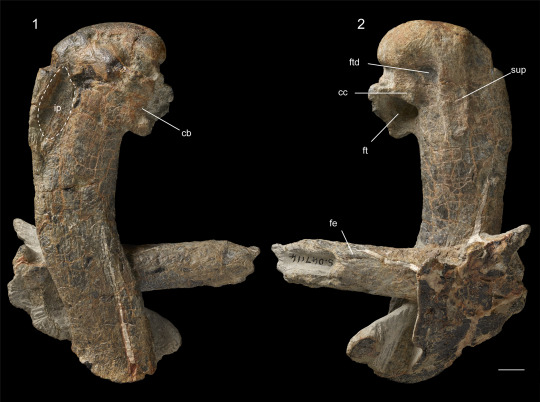
(Type specimen of Petradyptes stonehousei [scale bar = 10 mm], from Ksepka et al., 2023)
Meaning of name: Petradyptes = rock diver [in Greek, referring to the fact that its fossils were found after they had eroded out of rocky cliffs]; stonehousei = for Bernard Stonehouse [British biologist]
Age: Paleocene (Thanetian)
Where found: Moeraki Formation, Otago, New Zealand
How much is known: Five partial skeletons, together representing parts of the limbs and several vertebrae. An isolated tibiotarsus (fused shin and ankle bones) might also belong to this species.
Notes: Petradyptes was a close relative of modern penguins. Although not as big as Kumimanu, another early member of the penguin lineage known from the Moeraki Formation, Petradyptes was slightly larger than the largest extant penguin, the emperor penguin (Aptenodytes forsteri). Like modern penguins, Petradyptes was a flightless wing-propelled diving bird, but it still retained some similarities to flying birds in its wing skeleton, which may suggest that it was less specialized for diving than penguins are today.
Reference: Ksepka, D.T., D.J. Field, T.A. Heath, W. Pett, D.B. Thomas, S. Giovanardi, and A.J.D. Tennyson. 2023. Largest-known fossil penguin provides insight into the early evolution of sphenisciform body size and flipper anatomy. Journal of Paleontology advance online publication. doi: 10.1017/jpa.2022.88
25 notes
·
View notes
Text
and just a reminder, some of them are HUGE. male, adult emperor penguings can be as tall as 130cm (about 4 feet 3) !!!!
and don't let me begin on kumimanu penguins. they're extint now, but when they weren't (such an inteligent phrasing) milions of years ago, they were almost BLOODY 180CM (6 feet) HIGH!!! that's more than my height!!!
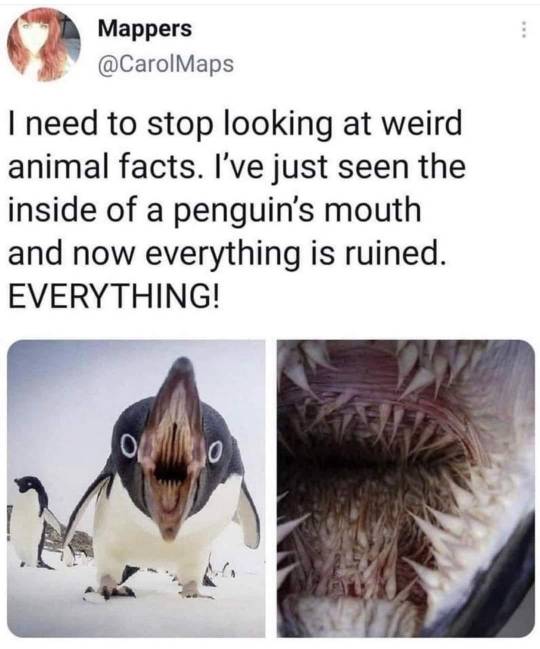
8K notes
·
View notes
Video
youtube
From Giant to Cute: The Huge Penguins of the Past Have you ever wondered what penguins looked like millions of years ago? Well, a new study has revealed some shocking information about these beloved birds. In this video, we'll explore the fascinating world of the huge penguins of the past. You'll learn about Kumimanu fordycei, an extinct penguin species that weighed up to three times more than the largest penguins alive today. We'll also talk about how researchers found fossils of these massive birds in New Zealand, and what they can tell us about penguin evolution. You won't want to miss this incredible story of how these little tuxedo-wearing birds used to be giants!
#penguins#Kumimanufordycei#Fossils#newzealand#extinct species#evolution#paleontology#size comparison#flightlessbirds#prehistoric creatures
0 notes
Text
Le ossa fossili del più grande pinguino mai vissuto portate alla luce in Nuova Zelanda
Ricostruzioni di come sarebbero apparsi Kumimanu fordycei e Petradyptes stonehousei. In Nuova Zelanda sono state rinvenute le ossa fossili di due specie di pinguini recentemente descritte, una delle quali si pensa sia il più grande pinguino mai vissuto, con un peso di oltre 150 chilogrammi, più di tre volte le dimensioni dei più grandi pinguini viventi. Un’équipe internazionale, comprendente…

View On WordPress
0 notes